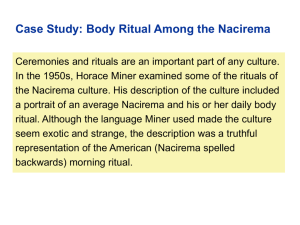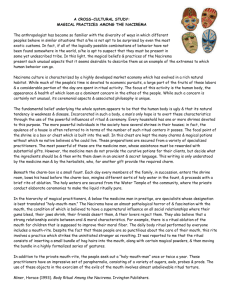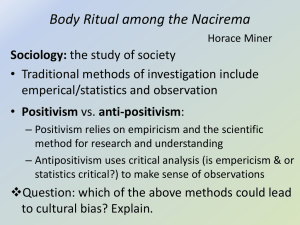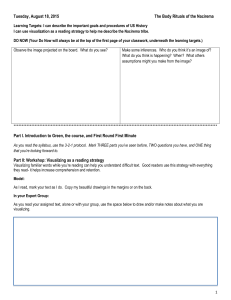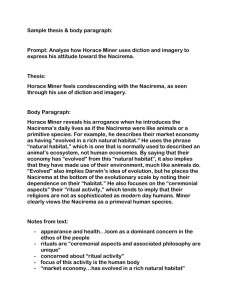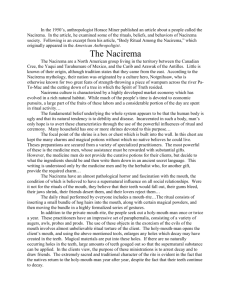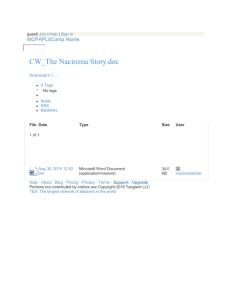What is culture
advertisement
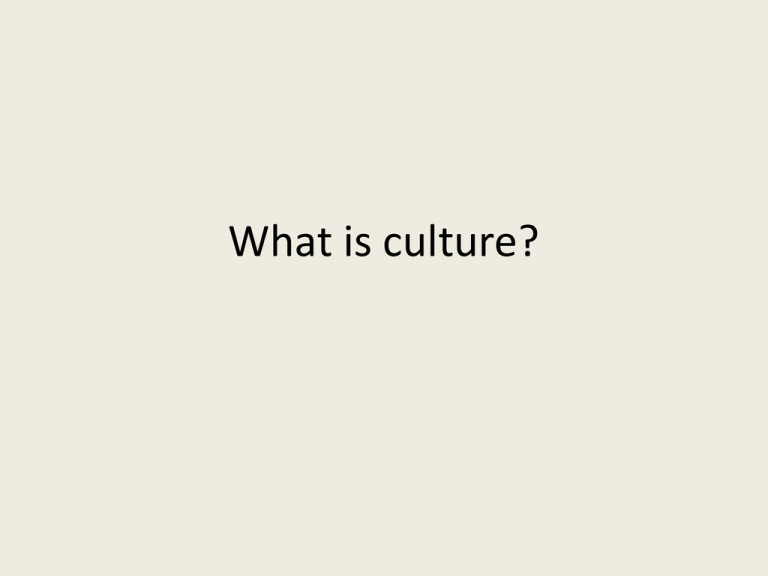
What is culture? Maslow’s Hierarchy of Needs SelfActualization Self-Esteem Belonging-Love Safety Physiological Needs Pursuit of inner talent creativity fulfillment Achievement mastery recognition respect Friends family lover community Security stability freedom from fear Food water shelter warmth sleep sex air Social group solutions to individual needs The vulnerable human The social group Cultural universals Cultural variations Culture How we fulfill our needs Material What we produce Non-material Symbols Language Norms Folkways/Mores/Taboos Sanctions Formal/Informal Material Culture Q. 1) What do you notice about people’s possessions and how they are placed in the photographs? Q.2) How are these possessions linked to Maslow’s hierarchy of needs? http://www.pbs.org/wgbh/nova/worldbalance/mate-india.html Photos by: Peter Menzel 2004 /menzelphoto.com Photos by: Peter Menzel 2004 China- The Wu Family China-The Wu Family The nine members of this extended family live in a 3-bedroom, 600-sq-foot dwelling in rural Yunnan Province. They have no telephone and get news through two radios and the family's most prized possession, a television. In the future, they hope to get one with a 30-inch screen as well as a VCR, a refrigerator, and drugs to combat diseases in the carp they raise in their ponds. Not included in the photo are their 100 mandarin trees, vegetable patch, and three pigs. India: The Yadev Family India: The Yadev Family 25-year old Mashre Yadev had her first child when she was 17 and is now mother to a total of four. Every morning, she draws water from a well so that her older children can wash before school. She cooks over a wood fire in a windowless, six-by-nine-foot kitchen, and such labor-intensive domestic work keeps her busy from dawn to dusk. Her husband Bachau, 32, works roughly 56 hours a week, when he can find work. In rough times, family members have gone more than two weeks with little food. Everything they own -- including two beds, three bags of rice, a broken bicycle, and their most cherished belonging, a print of Hindu gods -- appears in this photograph. Japan: The Ukita Family Japan: The Ukita Family 43-year-old Sayo Ukita had children relatively late in life, like many Japanese women. Her youngest daughter is now in kindergarten, not yet burdened by the pressures of exams and Saturday 'cram school' that face her nineyear-old sister. Sayo is supremely well-organized, which helps her manage the busy schedules of her children and maintain order in their 1,421-sq-foot Tokyo home stuffed with clothes, appliances, and an abundance of toys for both her daughters and dog. Despite having all the conveniences of modern life, the family's most cherished possessions are a ring and heirloom pottery. Their wish for the future: a larger house with more storage space. Mali: The Natomo Family Mali: The Natomo Family It's common for men in this West African country to have two wives, as 39-year-old Soumana Natomo does, which increases their progeny and in turn their chance to be supported in old age. Soumana now has eight children, and his wives, Pama Kondo (28) and Fatouma Niangani Toure (26), will likely have more. How many of these children will survive, though, is uncertain: Mali's infant mortality rate ranks among the ten highest in the world. Possessions not included in this photo: Another mortar and pestle for pounding grain, two wooden mattress platforms, 30 mango trees, and old radio batteries that the children use as toys. United States: The Skeen Family United States: The Skeen Family Rick and Pattie Skeen's 1,600-sq-foot house lies on a culde-sac in Pearland, Texas, a suburb of Houston. Rick, 36, now splices cables for a phone company. Pattie, 34, teaches at a Christian academy. Photographers hoisted the family up in a cherry picker to fit in all their possessions, but still had to leave out a refrigeratorfreezer, camcorder, woodworking tools, computer, glass butterfly collection, trampoline, fishing equipment, and the rifles Rick uses for deer hunting, among other things. Despite their possessions, nothing is as important to the Skeens as their Bible -- an interesting contrast between spiritual and material values Nonmaterial Culture Symbols What questions might you ask about this symbol? Symbol of what? Two times-Two Cultures-Two Swastikas auspiciousness and good fortune -- literally, "It is well." The right-angled arms of this ancient sunsign denote the indirect way that Divinity is apprehended: by intuition and not by intellect. Hitler/Third Reich/Holocaust How might this symbol be related to Maslow’s hierarchy? SelfActualization Self-Esteem Belonging-Love Safety Physiological Needs George Murdock’s Cultural Universals 1 of 2 • • • • • • • • • • • • • • • • • • age-grading athletic sports bodily adornment calendar cleanliness training community organization cooking co-operative labor cosmology courtship dancing decorative art divination division of labor dream interpretation education eschatology (end of the world ideas • • • • • • • • • • • • • • • • • • ethics ethno-botany etiquette faith healing family feasting fire-making folklore food taboos funeral rites games gestures gift-giving government greetings hair styles hospitality housing hygiene George Murdock’s Cultural Universals 2/2 • • • • • • • • • • • • • • • • • • incest taboos inheritance rules joking kin groups kinship nomenclature language law luck / superstitions magic marriage mealtimes medicine obstetrics penal sanctions personal names population policy postnatal care pregnancy • • • • • • • • • • • • • • property rights propitiation of supernatural beings (atoning sacrifice) puberty customs religious ritual residence rules sexual restrictions soul concepts status differentiation surgery tool-making trade visiting weather control weaving Cultural variations What forces might shape cultural differences? Ethnocentrism and Cultural relativism Horace Miner’s “Body Ritual Among the Nacirema” “The fundamental belief underlying the whole system appears to be that the human body is ugly and that its natural tendency is to debility and disease.” “Incarcerated in such a body, man's only hope is to avert these characteristics through the use of ritual and ceremony. Every household has one or more shrines devoted to this purpose”. “The focal point of the shrine is a box or chest which is built into the wall. In this chest are kept the many charms and magical potions without which no native believes he could live”. “In the hierarchy of magical practitioners, and below the medicine men in prestige, are specialists whose designation is best translated as "holy-mouth-men." The Nacirema have an almost pathological horror of and fascination with the mouth, the condition of which is believed to have a supernatural influence on all social relationships”. “The medicine men have an imposing temple, or latipso, in every community of any size. The more elaborate ceremonies required to treat very sick patients can only be performed at this temple. These ceremonies involve not only the thaumaturge but a permanent group of vestal maidens who move sedately about the temple chambers in distinctive costume and headdress”. “There remains one other kind of practitioner, known as a "listener." This witch-doctor has the power to exorcise the devils that lodge in the heads of people who have been bewitched. The Nacirema believe that parents bewitch their own children. Mothers are particularly suspected of putting a curse on children while teaching them the secret body rituals”. “Our review of the ritual life of the Nacirema has certainly shown them to be a magic-ridden people”. “It is hard to understand how they have managed to exist so long under the burdens which they have imposed upon themselves”. “Looking from far and above, from our high places of safety in the developed civilization, it is easy to see all the crudity and irrelevance of magic. But without its power and guidance early man could not have mastered his practical difficulties as he has done, nor could man have advanced to the higher stages of civilization”.
